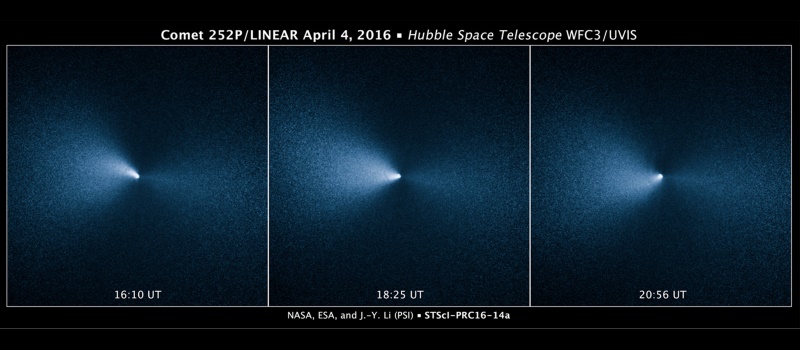- Home
- Science
- Science News
- Hubble Captured Rare Images of a Comet's Close Encounter With Earth
Hubble Captured Rare Images of a Comet's Close Encounter With Earth

These images were taken on April 4 (around two weeks after 252P/LINEAR made its closest sweep past our planet) when the comet was about 8.7 million miles away. The comet, which is 750 feet across, actually has a "twin" that flew about a million miles closer to the Earth a few days behind it. But at half 252P/LINEAR's size, the little sibling wasn't large or bright enough for a good close-up.
The time-lapse above uses frames taken between 30 and 50 minutes apart. The bright light - rotating like the beam of a lighthouse - is a jet of dust being emitted as the comet is warmed by the sun. Comets are made up of a core called a "nucleus" made of dust, ice, and dirt - basically a dirty snowball - that sublimates into a fuzzy aura called a "coma" under the warmth of the sun. What we're seeing is the resulting jet of material, shooting out in a narrow streak and illuminated by sunlight.
Scientists believe that the comet's nucleus is spinning in the time-lapse, causing the jet to sweep around like a beacon. Unfortunately, the comet was too small for the Hubble to resolve the nucleus itself.
Comet 252P/LINEAR is now more than 25 million miles away from Earth. Its orbit will return it to the inner solar system in just five years, but it won't come anywhere near as close as it did this time around.
© 2016 The Washington Post
For the latest tech news and reviews, follow Gadgets 360 on X, Facebook, WhatsApp, Threads and Google News. For the latest videos on gadgets and tech, subscribe to our YouTube channel. If you want to know everything about top influencers, follow our in-house Who'sThat360 on Instagram and YouTube.
Related Stories
- Samsung Galaxy Unpacked 2025
- ChatGPT
- Redmi Note 14 Pro+
- iPhone 16
- Apple Vision Pro
- Oneplus 12
- OnePlus Nord CE 3 Lite 5G
- iPhone 13
- Xiaomi 14 Pro
- Oppo Find N3
- Tecno Spark Go (2023)
- Realme V30
- Best Phones Under 25000
- Samsung Galaxy S24 Series
- Cryptocurrency
- iQoo 12
- Samsung Galaxy S24 Ultra
- Giottus
- Samsung Galaxy Z Flip 5
- Apple 'Scary Fast'
- Housefull 5
- GoPro Hero 12 Black Review
- Invincible Season 2
- JioGlass
- HD Ready TV
- Laptop Under 50000
- Smartwatch Under 10000
- Latest Mobile Phones
- Compare Phones
- Moto G15 Power
- Moto G15
- Realme 14x 5G
- Poco M7 Pro 5G
- Poco C75 5G
- Vivo Y300 (China)
- HMD Arc
- Lava Blaze Duo 5G
- Asus Zenbook S 14
- MacBook Pro 16-inch (M4 Max, 2024)
- Honor Pad V9
- Tecno Megapad 11
- Redmi Watch 5
- Huawei Watch Ultimate Design
- Sony 65 Inches Ultra HD (4K) LED Smart TV (KD-65X74L)
- TCL 55 Inches Ultra HD (4K) LED Smart TV (55C61B)
- Sony PlayStation 5 Pro
- Sony PlayStation 5 Slim Digital Edition
- Blue Star 1.5 Ton 3 Star Inverter Split AC (IC318DNUHC)
- Blue Star 1.5 Ton 3 Star Inverter Split AC (IA318VKU)

















